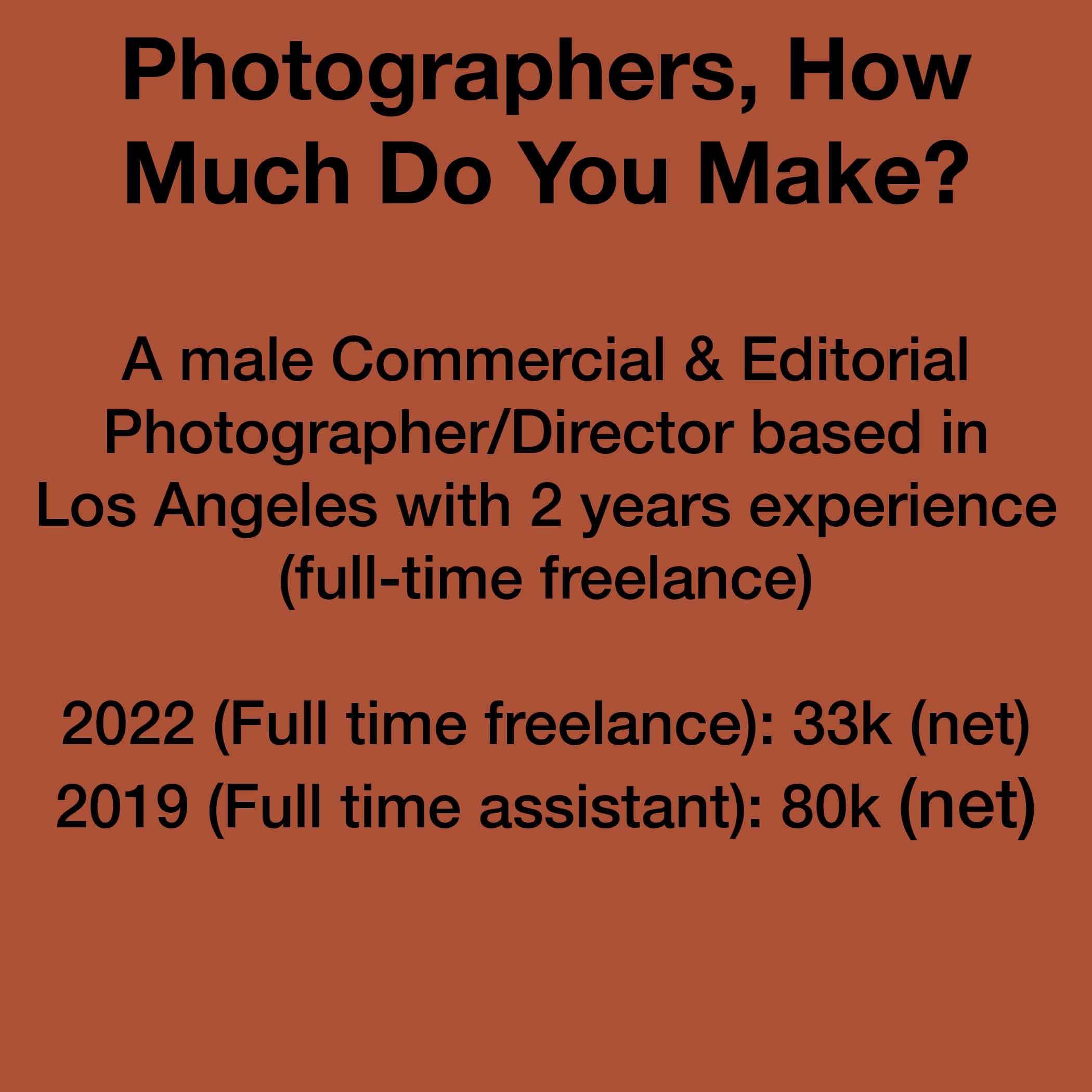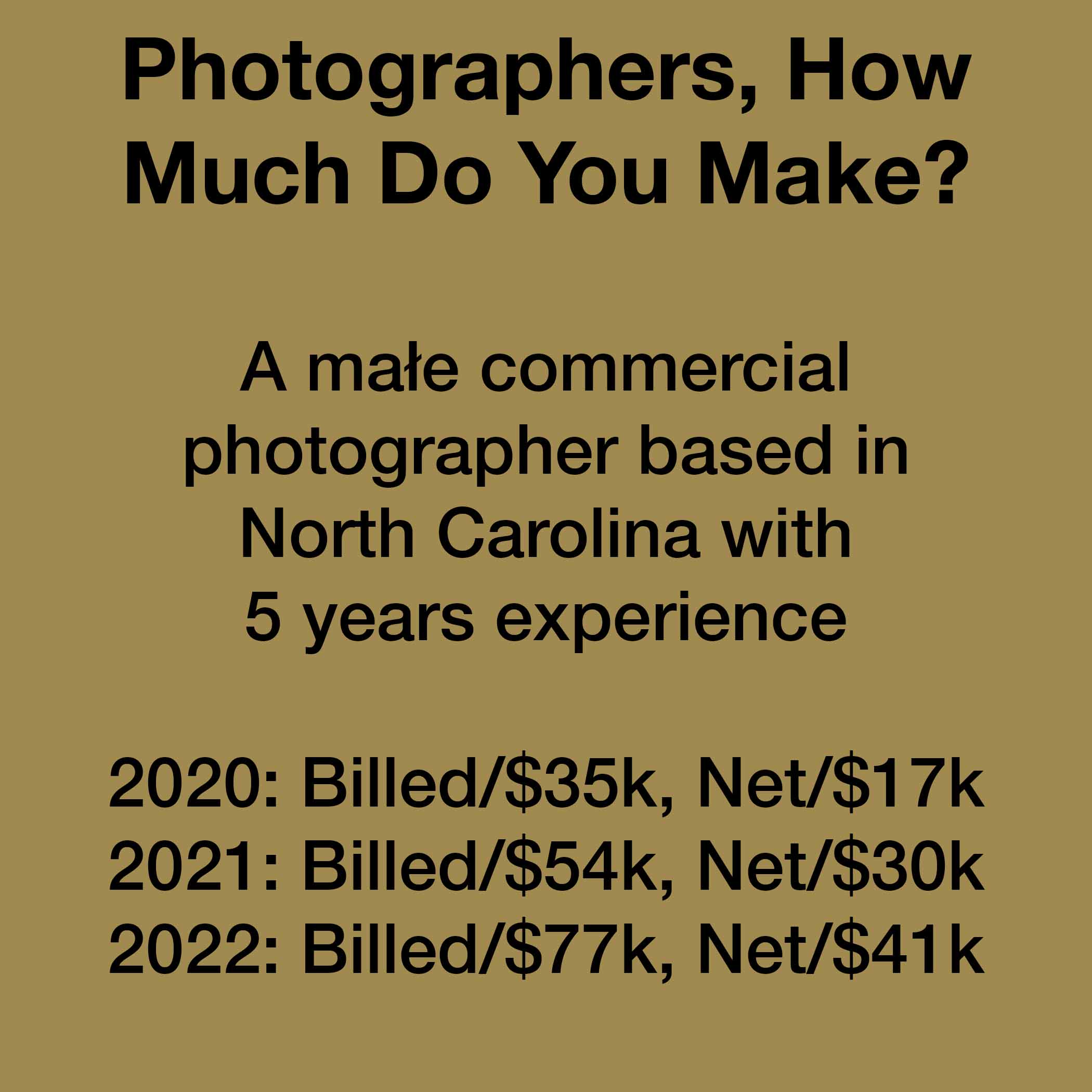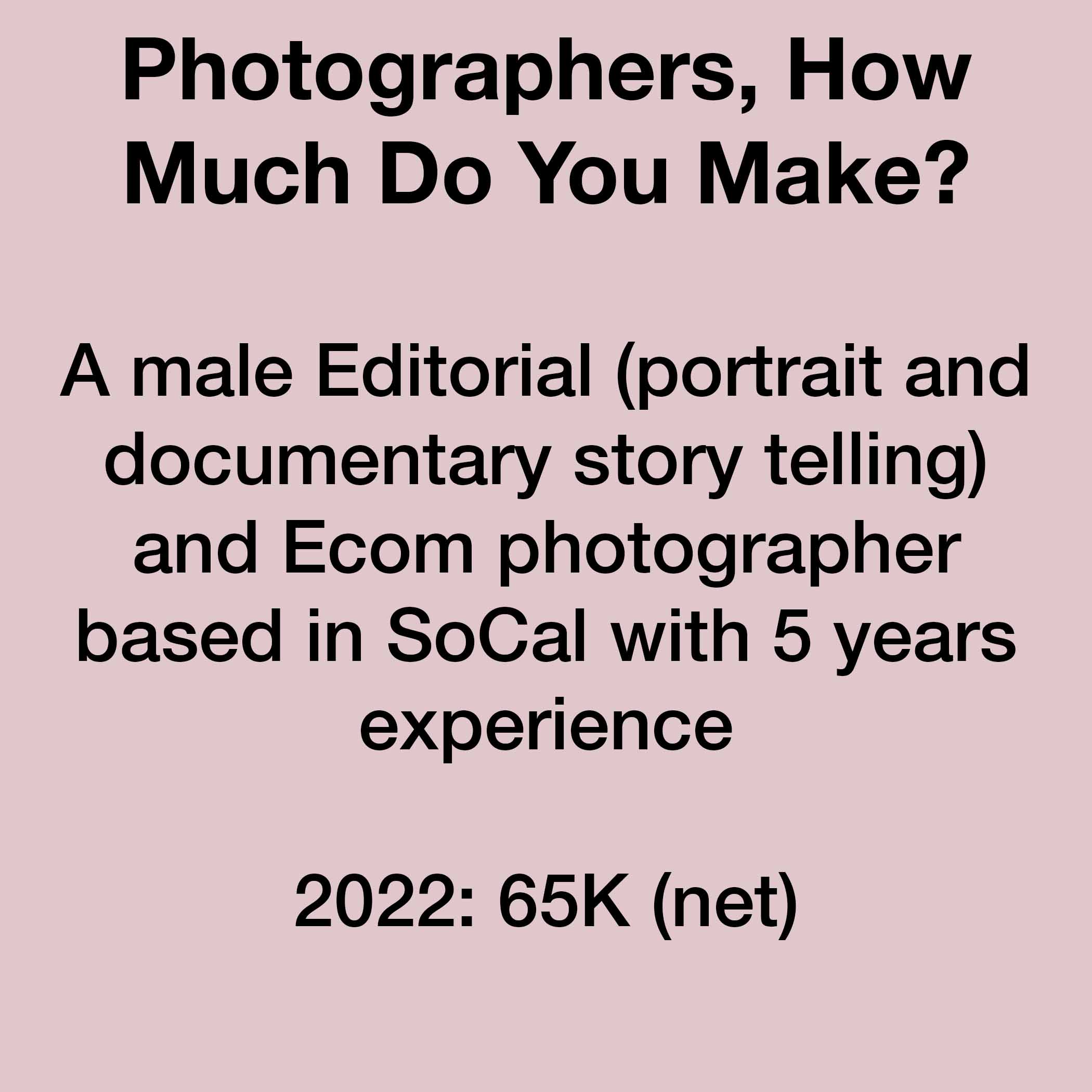My income is mainly from commissions, although recently, I’ve been uploading my archive to an agency.
Editorial shoots 1-4hr / Commercial 10hr / Motion 12hr.
My best-paying recent shoot was 3 days for a major international brand and 2 travel days. Creative was client-direct, so there were no big agency budgets, and unfortunately, a buyout (Due to their ancient legal team). I’m able to use the images for my promotion, though. 4.5k day fee+usage and 1.5k travel. I charge on personal equipment and normally try and make some off the expenses if there are costs I can cut.
My worst-paying recent shoot was 2.5k for a national brand’s new “editorial” magazine. 2 shoot days, paid assistant out of my fee, and didn’t make any expenses. Took it solely for the value of the creative & access to talent. I made images I’m very proud of, and so it made the fee worth it, but it seems to be a trend with companies making these “editorial” magazines to create imagery they’re also able to use commercially (this one, thankfully, I was able to push back on with usage).
Recently transitioned into directing as well. Only shot 1 paid project and have financed 2-3 others to build my reel.
I spent 4 years as an assistant in LA, which I look back on very fondly. The ability to travel & work for some of the best photographers today was an experience I wouldn’t trade for anything. I quit as an assistant when I felt like I had stopped learning, and it felt more like a job. I needed to fully dive into my photography and invest time in marketing and shooting personal work. The first 2 years out of assisting were the most stressful of my life. I was barely making money and living off savings. Every dollar I made was invested in portfolio showings or personal projects. I still feel like I’m trying to make it, but this was the first year I didn’t lose money, and my work has been very well received in agency meetings, so I’m hopeful for the future.
This year I also learned that the industry causes me immense stress and depression when things are slow. Working on inspiring personal projects for the love of it or donating my time to non-profits immediately inspires me to keep going.
Adventure – 90%, Portraiture – 10%
My clients are all over the US. I am still acquiring and upgrading my gear so that eats up quite a bit of my profits.
I also work a full-time job, so I work 7 days a week most of the year.
Photography specifically – on location 60 days; marketing, social media, emails, and bookkeeping – the other days.
I try to align myself with clients who have the same values that I do. So they are sustainable, earth-conscious, and lovely humans and companies. I have been able to find my niche and my people, and that has made my income almost triple in a single year.
I have a difficult time not knowing where my next job is coming from, so the stable paycheck from my full-time job gives me peace of mind. It’s a lot to manage both, especially this past year, but I love what I do.
I feel like there are no typical days in my photography career. One thing that is constant is the long hours, 8-14 hours, and quick turnaround times. A lot of jobs are for social media or advertising purposes.
Just barely dipping my toe into video, not doing it for work yet.
My advice to other photographers just starting out is: you got this! Put your head down and do the work, network, and you’ll find your way.
80% commercial, 10% food & bev, 10% event/other. My clients are local to NC or SC and the Southeast. Most are local agencies, a few out-of-town agencies each year, local brands & commercial projects in tandem with film productions.
My only overhead is gear upkeep & upgrades, software & insurance .
I’ve re-invested significant portions of my first years of income back into my equipment, so it’s a little hard to say what my profit margin is.
2021: 134 days (incl. edit days) / 42 projects / 21 clients. 2022: 118 (incl. editing days) / 58 projects / 31 clients.
Generally speaking, I’ve been working less & earning more as I find my footing in photography.
My other income source is digitech/assisting support roles, occasional video support positions and I co-own a vid production company.
To local/regional clients, I frame my rate as $850-$1750 dependent upon project scale (typically stating the lower end is for small business, nonprofits). A vast majority of my shoots are without assistance, and so my quote is my take-home-pay. My average pay for on-set days in ’22 was about $875, but this is averaging in my photographing days with my digitech/assisting days.
My best recent shoot was for a regional brand: single-day shoot (<10hr), budget $5975, take-home pay $4575 (1750 rate, 300 equipment, 2525 licensing in perpetuity).
My worst recent shoots are $200 PA days and $300/day unit stills w/ no box rentals for an ULB feature, etc.
I do not shoot video.
I’m “newly” repped (but not officially on the roster yet) since early 2022 but have not worked on a job yet with my reps. All the jobs I’ve gotten have been on my own and my reps are now working to bring new bids to me etc. Because I’m not officially on their roster I’m able to choose which jobs I bring to them currently. If I don’t need their help for a job I often won’t bring it to them to keep that 25% of my earnings. I won’t have that freedom once I’m officially on their roster, but I won’t officially go on their roster unless the work they bring me and assist me in marketing myself to get, pays well enough to justify the 25% they take.
I shoot 50% food, 50% product/still life mostly with national/ international/fortune 500 and some more localized mid size businesses sprinkled in there.
My clients are generally great. They’re either coming to me brand direct or through an ad agency. Most are mid-large national/international companies so they’re well versed in being on set and the costs that come associated with that. Not to say they’re not starving to reduce their costs all the time, because they are. Most of my shoots are timed pretty well without being TOO stressful, but there has definitely been an upward trend of inquiries and clients asking for really crazy shot counts for 1 or 2 day shoots and we just have to go with it.
My overhead is generally low, and was low for most of 2022. My largest incurred expenses were new equipment purchases on bigger ticket items like a macbook, iphone, aputure, lights, and modifiers. Equipment costs vary every year for me. Sometimes I’m buying lots of new stuff for a specific purpose and sometimes I’m not buying any new equipment. I try to only buy equipment when I really need it, and not because it’s new and exciting because that can get out of hand quickly. Travel was the second most expensive expense as I traveled back and forth between NY and LA frequently throughout the year for shoots. I work as a local in both cities so travel at my own expense. Otherwise I had the cost of insurance which was around $1000 a year, and all the little expenses that add up like test shoots, marketing, portfolio reviews, etc. Biggest overhead costs in 2023 are studio and equipment/liability insurance right now. I’m part of a studio share with 3 other people and pay $1000 a month for at least 5 full days of studio use, if not more. Insurance costs me $1330 a year right now.
I started working commercially full time In 2021 so my earnings took a steep increase in 2022 when I worked commercially full time the whole year.
An average shoot for me is going to be a 1 or 2 day in studio shoot. All my shoots are 10 hour days. Most of my jobs are in the production budget range of 14k-120k. 14k would be a pretty pared down one day shoot in studio with a prop stylist, prop stylist assistant, photo assistant, and digi tech. We’d likely shoot anywhere from 10-20 images/stop motions in tabletop or small built out sets. If the styling or creative is particularly complex that shot count will reduce to something like 5-10 images/stop motions. Take home pay on jobs like these is usually something like $4-9k with a $2000-4000 day rate, $1500-3500 licensing costs for website, organic and paid social, email marketing, (and maybe 3rd party press) and $1000-3000 in post production costs which I do myself. I usually take home something like $500-1000 for my equipment as well. 120k would be a 2-3 day full production that’s more lifestyle esc and has more involved sets and propping and usually a crew that includes these positions: 1st and 2nd photo assist, digi tech, prop stylist, 1-2 prop assistants, food stylist, 1-2 food styling assistant, producer, production coordinator, PA. If the set includes any talent then add on costs and crew for that: manicurist, hair/makeup, wardrobe, etc. Take home pay on a job like this would be in the $10-25k range with a $3-5k day rate, $3000-20,000 in licensing costs for website, organic and paid social, email marketing, some print, some other paid advertising use and $1500-5000 in post production take home. I probably take home something like $1000-2000 for my equipment as well.
My best paying shoot in 2022 was for huge fortune 500 food brand and my take home pay was $23,000 which includes my day rate + licensing only. I did not do post production on this project. We had a 2 day shoot in a studio in LA with one day going 1 hour overtime (with 1.5x hourly rate pay for myself and the whole crew which is accounted for in my take home pay) and the second day capping at 10 hours. We had to cut 2 variations to the stop motions we were shooting, but were otherwise able to get everything else we planned for. They received an exclusive license in perpetuity for 12 stop motion assets for organic social media, paid social media advertising, client website use, PR use and award use. All Videos were owned outright. I don’t normally like to give licensing in perpetuity, but had no choice and wanted this job and the pay.
My net has fluctuated + or – 5k the last few years and I’m just starting to land some proper advertising work.
My income is 70% Ecom, 30% editorial. Ecom rate is $1100/day. Editorial can range from $450 flat for a NYT assignment to $1500+ in pocket after day rate and charging for gear rental for a client such a Hearst publication.
I don’t currently have a rep, but have had two in the past. Worked with a freelance agent to help negotiate the most recent ad job.
My client are all over the US, some international.
Overhead includes gear upgrades every few years which usually cost 7-15k. I recently built out a cinema camera to start exploring personal projects that are video based. Crew depending on the project. Which ranges from $400-750/ person per day. Also food, travel, research etc.
Actual shoot days for Ecom are around 65 a year, Editorial about 24, the recent ad job was 1 scout, 1 fitting/prepro and 4 shoot and about 5 days worth or prepro, treatment creation and zoom calls. But I’m continually putting many hours and days into my craft. Whether its working on personal projects, promo emails, research and education. For example, became a drone pilot a few years ago and currently taking an online doc film making class.
My Ecom client is a high end athletics brand, landing them several years ago I was able to fully move from assisting to shooting which helped give me more freedom for personal work and editorial assignments. It’s also my bread and butter, I’m freelance but the client is very flexible. I can often get a day covered if an assignment comes up.
My editorial assignments are usually a lot of fun, I of course love being creative but also the personal experiences I often get from them are super important to me. I’ve often shot multiple 12 hr days in a row, for very little money, but it can be really rewarding.
End of 2021 and then the beginning of this year I shot two projects for the same client and creative agency. A tech company with a very large creative agency. First time fees were around 35k after an agent fee, this time around it was close to 100k. I really enjoyed shooting both those projects both on a creative level and in terms of career building, getting better at making treatments, conversing a lot on zooms and working with a crew of 25+ to get the shoot done. Its very different than my solo adventures in editorial story telling but I love the different challenges this kind of work brings.
My income over the last few years has been pretty steady. I was really lucky during the pandemic that Ecom work didn’t really slow down but for a few months. I also took advantage of two PPP loans that were forgiven. This year I will see a significant change from the large ad project I shot. I have a great accountant that I trust and helped me incorporate this year, that should also help me save some money.
I am starting to work more on venturing into film making. This is suggested by every agent, career consultant, etc. But I am honestly coming at it from a creative outlet standpoint. I’ve enjoyed telling stories through stills for several years now and I want to challenge myself and expand my story telling capability through motion.
I took a pretty standard path of assisting, to eventually landing editorial work based on my personal projects and then with some luck and personal relationships I made during my assisting years landed a steady Ecom client. Now the editorial body of work is landing me ad jobs. I’m grateful for this path, its been a slow but steady climb but all the experiences have made me very confident in what I do both logistically and creatively.
I think the most important thing is be passionate, don’t just shoot a test or get into video because its what you are being told that’s what you should do. Do it because you really want to. I think your potential clients, followers, editors, art buyers etc, can feel the passion behind a body of work. I’m currently reading The Anatomy of Story by John Truby and he talks about “write(ing) something that may change your life.” That this kind of story will resonate most deeply with an audience and has the highest likelihood of success. Maybe that’s a bit heavy, but you get the idea. Be passionate.




